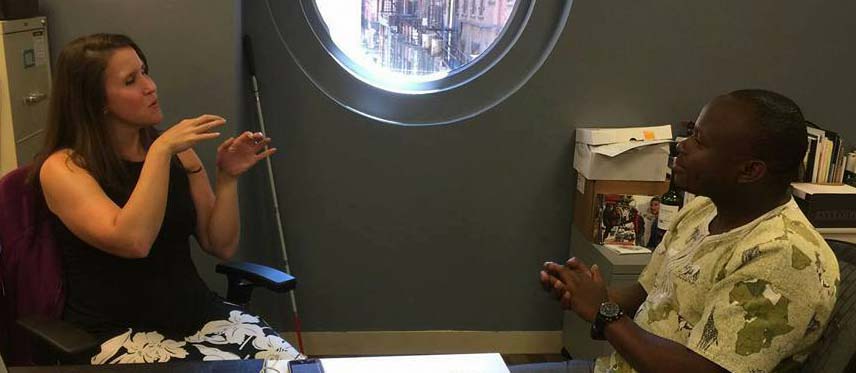Blog
DeafBlindness: The Left Behinds in a Leave No One Behind Era

Kerry Thompson signs with Ambrose Murangira from Uganda
As an American living with DeafBlindness, I recognize that I have had easier access to attaining my rights to education, employment, and inclusion due to the Americans with Disabilities Act (ADA). But even with the ADA, the vast majority of those in the US living with DeafBlindness are still marginalized and isolated from society due to widespread discrimination, a lack of resources and a unifying national movement.
Another reason for the marginalization of the DeafBlind is how few of us there are. Usher Syndrome, my form of DeafBlindness, which usually results in deafness at birth with gradual blindness due to retinitis pigmentosa, affects 4-5 per 100,000 people (Source: U.S. National Library of Medicine). which usually results in deafness at birth with gradual blindness due to retinitis pigmentosa. We are significantly lower than 1% of the world’s population.
Eight years ago, I became the second hire at Disability Rights Fund (DRF). That same year, DRF was established and the UN Convention on the Rights of Persons with Disabilities (CRPD) entered into force. Though I had considered myself to be a lifelong disability rights advocate due to my own disabilities, not until I joined DRF did I experience the paradigm shift that disability rights is a human rights issue.
Being part of DRF since its inception, I have had a front row seat to witnessing the achievements of the global disability rights movements since the CRPD was adopted in 2007. I cheered the 160 times a country ratified the CRPD, though my own country, the US, has not yet ratified.
DRF, as well as a number of development agencies such as the UK’s Department of International Development, recognize persons with DeafBlindness to be among the most marginalized of the marginalized. Despite the recognition of marginalization of persons with DeafBlindness, too many of us are absent from disability rights movements at national levels.
Persons with disabilities as a group are one of the most marginalized populations in the world, and persons with DeafBlindness are among the most marginalized within this population. Why? The size of the population of persons with DeafBlindness is minuscule, which often has us on the fringe of society. Like other marginalized populations such as those with intellectual or psychosocial disabilities, our capacity to participate, to achieve self-determination, and to lead is wrongly called into question, even by other members of the disability community. We also face more barriers in communications due to limited access to language.
We are too often absent from high-level meetings at national levels, and from consultation in preparation of parallel reports to UN monitoring mechanisms; we are also often absent from country-level conferences and trainings on the Sustainable Development Goals.
The vast majority of the disability rights movement at national levels and even my own peers acknowledge the lack of sufficient representation of people with DeafBlindness in the movement.
We need to do more than acknowledge the issue; we need to solve the issue.
One of the hallmarks of DRF is the inclusion of marginalized groups and below I share my four-point plan for inclusion of the DeafBlind in the disability rights movements:
- Break down the communication barriers
We need to break down the communication barriers that exist between the DeafBlind and other disability groups; we need to break down the communication barriers between the Deaf and DeafBlind as well as the DeafBlind and the Blind; and more importantly we need to break down the communication barriers internally among the DeafBlind in order to strengthen our voice and movement.
- Develop partnerships and cross-movements
A large number of Disabled Persons Organizations (DPOs) for the Deaf are working towards national recognition of sign language as well as the inclusion of sign language in public, private, and government sectors. However, many of these efforts fail to acknowledge tactile sign language in their efforts. DeafBlind organizations could build partnerships with Deaf organizations at the national level uniting their efforts to remove communication barriers for both the Deaf and DeafBlind.
- Promote self-advocacy and foster independence
There are a growing number of parents’ organizations working on inclusive education of the DeafBlind. These parents’ organizations should also be teaching their children to self-advocate and foster independence which will be key in growing the next generation of DeafBlind leaders to sustain the movement.
- Build capacity and fund advocacy
Most organizations for the DeafBlind tend to focus on services rather than activism. The few organizations of the DeafBlind with DeafBlind leaders tend to lack capacity and funds causing their stagnation. Donors should be thinking about funding DeafBlind organizations in two-parts – to remove their communication and financial barriers, in addition to funding the advocacy work.
The theme of this year’s International Week of the Deaf was “With Sign Language, I am Equal” which took place September 19 – 25. Additionally, September 17 was the second annual Usher Syndrome Awareness Day. I celebrate both and my vision is a stronger, unified DeafBlind movement at all national levels that is capable of partnering with the larger national disability rights movements on equality and attaining our rights.
Kerry Thompson is the Senior Officer of Communications, Inclusion, & Analytics at Disability Rights Fund. She is also a 2014 Marshall Memorial Fellow. She is the Director of Silent Rhythms – a dance organization that teaches dance to people of all abilities. She serves on the Board of Directors for DEAF, Inc. and a Board liaison for DeafBlind Community Access Network Advisory Council. She also serves on the Massachusetts Commission for the Deaf and Hard of Hearing Statewide Advisory Council. She received her master’s degree from Harvard University.
You can read more about Kerry in her Crossing the Street- Lessons from a Self-Advocate blog post.